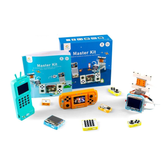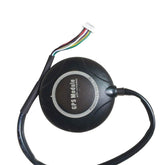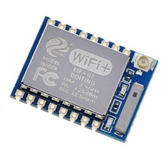-
HC-06 Bluetooth ModuleHC-06 Bluetooth Module The HC-06 Bluetooth Module is a cost-effective solution designed for establishing short-range wireless data communication between two microcontrollers or systems. Using Bluetooth 2.0 communication protocol, it can only function as a slave device. Compared to other methods, it provides more flexibility...
- Rs. 283
Rs. 385- Rs. 283
- Unit price
- per
Save Rs. 102 -
TTGO T-Call V1.4 ESP32 SIM800L Wireless Communication ModuleTTGO T-Call V1.4 ESP32 SIM800L Wireless Communication Module You're looking at an unsoldered TTGO TCall ESP32 SIM800L module with a SIM antenna and SIM card slot. This module is a wireless communication module that connects any microcontroller to your WiFi network via the ESP...
- Rs. 2,144
Rs. 2,749- Rs. 2,144
- Unit price
- per
Save Rs. 605 -
SIM900A GSM GPRS Module with RS232 Interface and SMA AntennaSIM900A GSM GPRS Module with RS232 Interface and SMA Antenna The SIM900A Modem incorporates the SIM900A GSM module from SIMCOM, a dual-band GSM-based modem. It operates within the 900MHz frequency range and has the capability to automatically search for these two bands. Additionally, the...
- Rs. 943
Rs. 1,049- Rs. 943
- Unit price
- per
Save Rs. 106 -
ESP8266 Wroom Downloader Burning Fixture Tool Programming BoardESP8266 Wroom Burning Fixture Tool Downloader The ESP8266 development fixture board can be used to program ESP8266 chips for development and small-batch production. The development board comprises fixtures for the ESP32 modules with an inbuilt CP2104 USB-TTL chip and an AMS1117 3.3 version regulator...
- Rs. 599
Rs. 699- Rs. 599
- Unit price
- per
Save Rs. 100 -
RFID Card ReadRFID Card Read RFID, or radio-frequency identification, is a technology that allows for contactless communication between a reader and an RFID tag or card. RFID card readers can be used in various applications, including asset tracking, inventory management, and access control systems. RFID Cards...
- Rs. 19
Rs. 24- Rs. 19
- Unit price
- per
Save Rs. 5 -
Lolin Node MCU baseLolin Node MCU base The NodeMcu Lua WIFI Development Board ESP8266 Serial Port Baseboard is a networking platform that is open source. It is programmed in the Lua scripting language. This baseboard is the Breakout Board for our NodeMcu ESP8266 V3 Lua CH340 Wifi Dev. Allows...
- Rs. 106
Rs. 149- Rs. 106
- Unit price
- per
Save Rs. 43 -
Airgain N2420 2.4 Ghz 4DB WiFi Omnidirectional Antenna - IPEX-IPX (Set of 2)Airgain N2420 2.4 Ghz 4DB WiFi Omnidirectional Antenna 2.4GHz built-in PCB antenna N2420, is our company's well-designed dipole PCB antenna, the gain is up to 3.5dBi (+/-0.5), the effect is comparable to the external rod-shaped omnidirectional antenna. The wire uses a low-loss high-frequency coaxial...
- Rs. 79
Rs. 109- Rs. 79
- Unit price
- per
Save Rs. 30 -
Mini elm327 Bluetooth OBD2Mini elm327 Bluetooth OBD2 ELM327 Bluetooth OBD2 Works on all 1996 to 2010 cars and light trucks. Software included in CD for smartphones (Android, Symbian), PC(Windows XP, Windows 7, and Windows 8). OBD-II Software for ELM327 Bluetooth is a free program that allows you to use your...
- Rs. 185
Rs. 349- Rs. 185
- Unit price
- per
Save Rs. 164 -
ESP8266 ESP-01 ESP-01S Breakout Board Breadboard AdapterESP8266 ESP-01 ESP-01S Breakout Board Breadboard Adapter ESP8266 ESP-01 ESP-01S Breakout Board Breadboard Adapter simplifies the prototyping process, providing a hassle-free experience for ESP8266 serial to WIFI transceiver modules. Crafted with durability in mind, this board is perfect for IoT enthusiasts and DIY projects....
- Rs. 29
Rs. 34- Rs. 29
- Unit price
- per
Save Rs. 5 -
Witty Cloud ESP12F ModuleWitty Cloud ESP12F ESP8266 Serial WiFi Development Board (Mini Node MCU Module) The ESP8266/ ESP-12F Module/ Serial WIFI Witty Cloud Development Board + MINI nodeMCU is a cheap and small Wifi transceiver, a perfect solution for Home Automation and IoT applications. It can be the replacement for...
- Rs. 248
Rs. 349- Rs. 248
- Unit price
- per
Save Rs. 101 -
F18468-70 NEO-7M 7M GPS Module with Compass for APM2.5 2.6 2.8NEO-7M GPS Module with Compass The NEO 7 series introduces a remarkable GPS module with a built-in compass, known as the NEO-7M. It is a highly sensitive and energy-efficient module, featuring 56 channels that deliver precise position updates at an impressive rate of 10Hz....
- Rs. 1,677
Rs. 1,945- Rs. 1,677
- Unit price
- per
Save Rs. 268 -
ESP32 CP2102 Wireless Development Board D1 LOLIN32ESP32 CP2102 Wireless Development Board D1 LOLIN32 The D1 LOLIN32 ESP32 CP2102 Wireless Development Board is a small yet powerful device that improves the adaptability and effectiveness of your Internet of Things projects. Based on the reliable ESP-32 chip, this board has 4MB of...
- Rs. 449
Rs. 599- Rs. 449
- Unit price
- per
Save Rs. 150 -
125KHz EM4100 RFID Card Read Module125KHz EM4100 RFID Card Read Module The 125KHz Card Mini-Module is designed for reading code from 125KHz/ 134.2KHz card-compatible read-only tags and read/write a card. It can be applied in office/home security, personal identification, access control, anti-forgery, interactive toy, and production control systems. This module is easy...
- Rs. 249
Rs. 371- Rs. 249
- Unit price
- per
Save Rs. 122 -
Bluetooth 5.0 Dual Mode BLE (Feasycom)Bluetooth 5.0 Dual Mode BLE (Feasycom) The Bluetooth 5.0 Dual Mode BLE (Feasycom) is a high-performance, highly integrated Bluetooth 5.0 BR/EDR/BLE dual-mode module. It operates on the 2400MHz to 2480Mhz ISM frequency band and has a low power consumption of 5mA working current. It...
- Rs. 449
Rs. 599- Rs. 449
- Unit price
- per
Save Rs. 150 -
ESP8266 Serial WIFI Wireless Transceiver Module ESP-07 Send Receive LWIP AP Plus STAESP8266 Serial WIFI Wireless Transceiver Module ESP-07 Send Receive LWIP AP Plus STA The ESP-07 WiFi module is developed by AI-Thinker Co., Ltd, has an ultra-low power 32-bit MCU micro, with a 16-bit short mode, clock speed support 80 MHz, 160 MHz, supports the RTOS,...
- Rs. 230
Rs. 263- Rs. 230
- Unit price
- per
Save Rs. 33 -
RFID Access Control Door LockRFID Access Control Door Lock External reader one weigand26 interface. Lock interface relay output or level output Exit button one interface Bellone interface.
- Rs. 789
Rs. 1,285- Rs. 789
- Unit price
- per
Save Rs. 496 -
SIM 800A GSM Modem with SMA AntennaSIM 800A GSM Modem with SMA Antenna The SIM800A Dual-Band GSM/GPRS Module with RS232 Interface is a complete solution for Dualband GSM/GPRS communication. With the SIM800A GSM module, you can transmit voice, texts, and data over mobile carriers and communicate with it using protocols...
- Rs. 824
Rs. 999- Rs. 824
- Unit price
- per
Save Rs. 175 -
125KHz Android Phone USB C Type RFID Reader125KHz Android Phone USB C Type RFID Reader This is a 125KHz Android Phone MicroUSB C Type RFID Reader. Connect the RFID Reader to your mobile phone micro–USB C Type port. If the LED colour (on RFID) is blue, that means it is ready...
- Rs. 999
Rs. 1,364- Rs. 999
- Unit price
- per
Save Rs. 365 -
XBEE USB ExplorerXBEE USB Explorer The XBee USB Explorer is a versatile board designed to simplify the connection of XBee modules to your computer. By plugging this board into the XBee Explorer, you can easily connect your XBee modules to your computer using a mini USB...
- Rs. 259
Rs. 369- Rs. 259
- Unit price
- per
Save Rs. 110 -
HM10 BLEHM10 BLE Bluetooth 4.0 module The HM-10 Bluetooth module is a widely available and inexpensive Bluetooth 4.0 module that enables wireless data communication. As the cheapest Bluetooth module with 4.0 technology, it offers the latest advancements at an affordable rate. Based on the TI...
- Rs. 389
Rs. 549- Rs. 389
- Unit price
- per
Save Rs. 160

Best Price Guarantee

Ready Stock for Bulk Purchase

Dedicated Account Managers

5% GST Benefits for Eligible SEZ and Edu

Technical Support Available

1-Year Manufacturer Warranty




















































